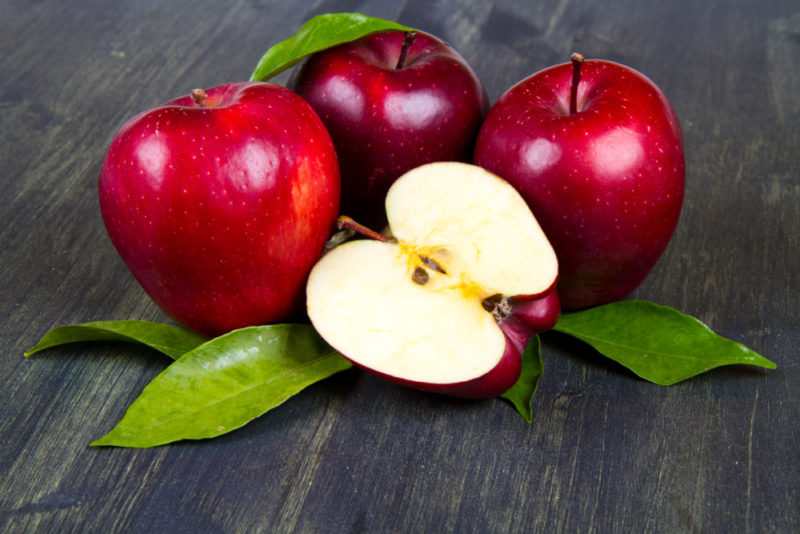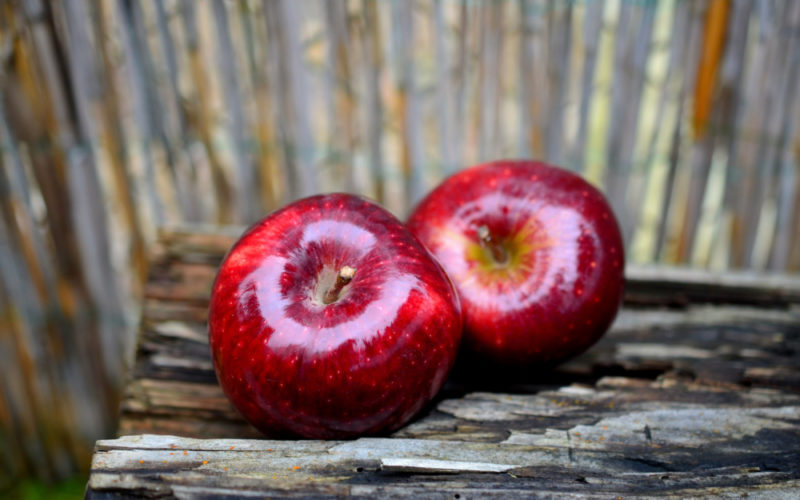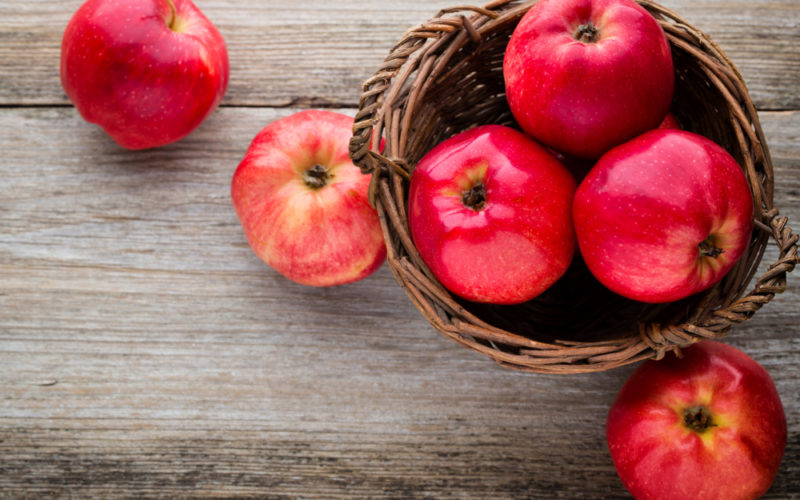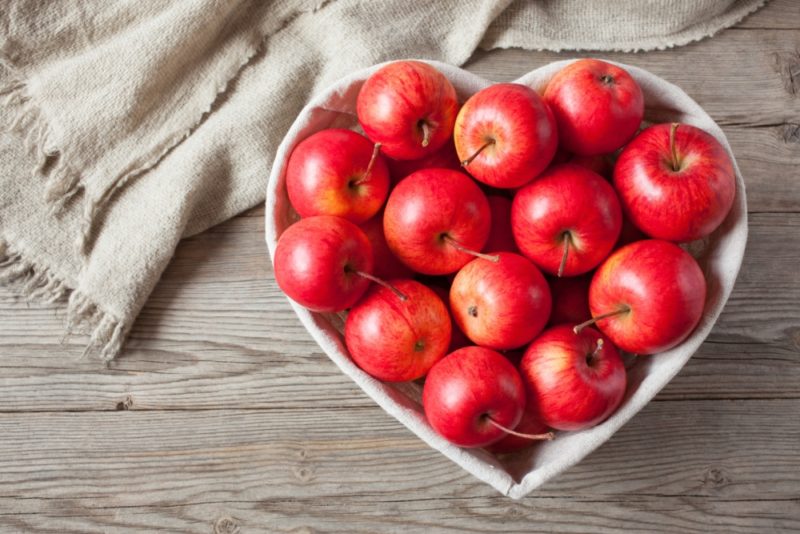It is interesting to know how many calories are in a red apple. Indeed, such information once again confirms: the fruit has many advantages, it is not only useful, but also harmless to the figure. Apples should be eaten every day, at any time of the year.
Material Content:
Composition and nutritional value of sweet varieties
On average, 100 g of apple contains:
- liquid in the form of apple juice - more than 80 g;
- proteins - about 0.25 g;
- mono- and polyunsaturated, as well as saturated fats - about 0.15 g;
- carbohydrates, including in the form of dietary fiber, sucrose, glucose, fructose, starch - almost 15 g.
Additional chemicals in the fruit are vitamins, macro- and micronutrients, malic and citric organic acids, salts and other compounds. It is enough for an adult to eat about 300 g of apples per day. Thanks to this, it will be possible to fully satisfy the daily need for vitamin plant foods.
Among the sweet varieties of apples are many noteworthy varieties. Idared is the leader in iron and vitamin C. There are fewer ascorbic acids in Medunitsa, but these apples are distinguished by dietary properties. They contain the optimal ratio of acids and sugars. Popular "Fuji" delight with a very sweet flesh. The nutritional value of the fruit decreases with prolonged or improper storage. And the most useful composition of local adapted varieties that are grown without the use of chemicals.
How many calories in a red apple
The nutritional properties of fruits depend on the time of harvest, growing conditions, characteristics and storage period of the fruit.Most of all, calorie content is influenced by variety. The approximate nutritional value of the Red Delicious, Jonathan, Jonagold and Melba apples is 45 kcal, Idared and Macintosh are 48 kcal, Fuji is 70 kcal.
This factor is influenced by many factors:
- The calorie content of a red apple is higher than that of a yellow or green one.
- Watery fruits are not as nutritious. After all, they have less carbohydrates, proteins and fats.
- The energy value of sour varieties is lower than that of sweeter varieties.
The average calorie content of 100 g of fresh red apples is from 40 to 60 kcal. The weight of a medium-sized fruit is about 150 g, about 70 kcal in it. If you choose a large fruit of a sweet variety, then in 1 pc. may be more than 200 calories.
They eat not only fresh apples, but also various dishes based on them:
- When baking, calories do not change. But if sugar or honey are additionally used in the cooking process, then nutritional value increases approximately 2 times.
- 100 g of dried fruits have much more calories than fresh ones. Depending on the variety in dried fruits, approximately 200-250 kcal.
- The most nutritious apple-based dishes are various jams, jams, preserves. The energy value of 100 g of such a sweet treat is more than 240 kcal.
The content of vitamins, trace elements
Apple surprises with its rich composition. In the pulp, skin and fruit seeds there are more than 28 types of various vitamins and minerals.
100 grams of fruit contains approximately:
- iron - 0.2 mg;
- potassium - 120 mg;
- magnesium - 4-6 mg;
- phosphorus - 10 mg;
- calcium - 5-7 mg;
- sodium — 1-2 mg;
- copper - 25 mcg;
- zinc - 0.03 mg;
- ascorbic acid - 5 mg;
- thiamine - 0.02 mg;
- riboflavin - 0.03 mg;
- niacin - 0.09 mg;
- vitamins B5 - 0.06 mg, B6 - 0.04 mg, B9 - 1.3 μg, E - 0.2 mg and K - 2 μg.
Apples are also saturated with other useful elements - chromium, nickel, fluorine, manganese, molybdenum, vitamins A and PP, biotin, beta-carotene and folic acid. In several apple bones there is a daily dose of iodine, which is necessary for the adult body.
The benefits of fruit for the body
Red apples have a beneficial effect on humans due to the advantageous chemical composition:
- Pectins reduce blood cholesterol. And also they will help get rid of harmful chemical compounds, which contain radioactive and heavy metals.
- Fiber improves intestinal motility, reduces the risk of cancer and fights constipation.
- Malic and citric acids have beneficial effects on the gums and teeth, improve metabolic processes in the body.
- Vitamins, antioxidants and phytoncide compounds increase immunity, reduce the risk of developing infectious ailments and neutralize the negative effects of free radicals. They positively affect attention and memory, allow you to maintain clarity of thinking, increase stress resistance.
Fruits are recommended to eat with problems in the work of various organs.
What benefits will bring them:
- due to the low glycemic index, carbohydrates in apples are slowly absorbed, therefore, they are indispensable for patients with diabetes;
- participate in lipid metabolism, the formation of new body cells, the production of hemoglobin;
- strengthens hair and nails, blood vessels and muscles, bone tissue;
- contribute to maintaining good vision for many years;
- improve the condition of the skin;
- the skin of apples contains substances that protect against cancer;
- stabilize the intestinal microflora;
- reduce the negative effects of cigarette smoke on the lungs of smokers.
Apples prevent the development of many ailments of the cardiovascular, digestive, urinary, nervous, endocrine and immune systems. Atherosclerosis, heart attack, stroke are less common among those who regularly consume delicious fruits. With excess weight and during the diet, they will help break down fats and contain few calories, so they are used for weight loss.
Contraindications
Apples are a delicious food product with healing properties, but they should be used in the diet wisely.
There are no direct contraindications to their use, but there are certain limitations and precautions:
- Imported fruits from supermarkets look very attractive due to the bright glossy finish. Often, a delicious appearance is the result of additional surface treatment of apples with wax and harmful chemicals. In this way, manufacturers attract customers and also increase the shelf life of the fruit. The skin of too shiny fruits must be cut off and discarded before eating the pulp.
- The most useful are seasonal local apples that are not “overfed” by chemistry. They are thoroughly washed and eaten with a peel that contains many useful substances. Homemade fruits are tastier and have a more balanced composition.
- Normally, no more than 400 g of a tasty product is eaten per day, and up to 1 kg of fruit during the apple diet. Do not abuse apples. This can lead to disruptions in the digestive tract, cause flatulence, bloating and other problems in the body.
- In rare cases, individual intolerance to apples is observed.
- Acidic varieties are not recommended to be introduced in the menu for diseases associated with increased gastric acidity.
- Unsweetened species are preferred in the presence of diabetes.
- Fruits, when consumed frequently, can damage tooth enamel.
- Small apple seeds have a unique useful composition, but you can not eat more than 4 such seeds per day. They contain a lot of poisonous hydrocyanic acid, which can cause poisoning.
- Due to the presence of beta-carotene in the pulp, red apples cause allergies more often than other varieties. For this reason, green fruits are chosen for baby food. With a tendency to allergic reactions, eating brightly colored varieties is also not recommended.
Deserved popularity of apples in the menu of adults and children is easy to explain. Even in ancient times, doctors recommended eating a couple of fruits a day in order to maintain health for many years. These delicious fruits continue to attract low calories, beneficial properties and affordability.

















